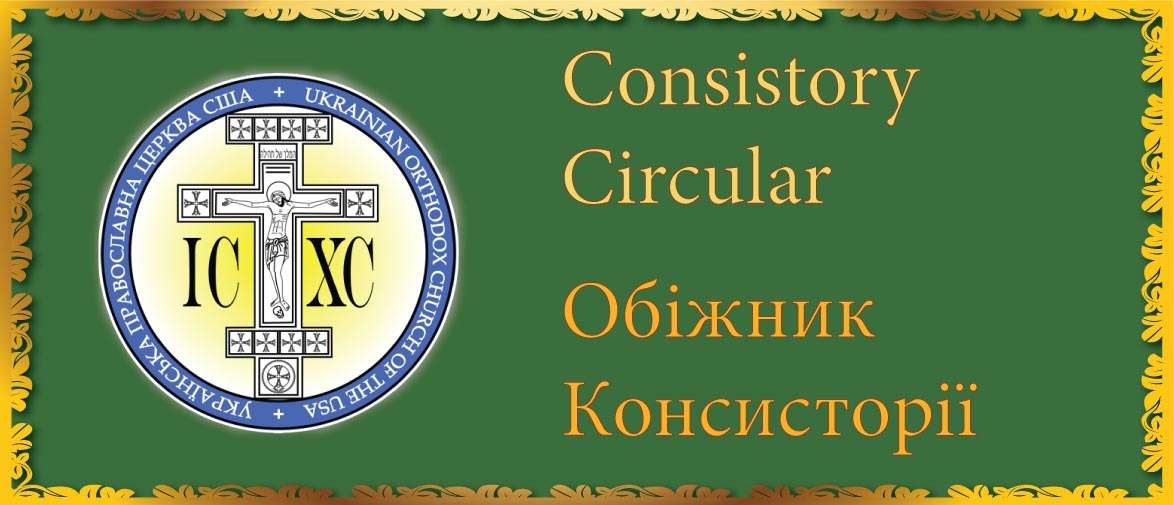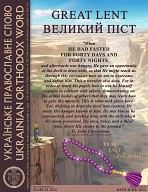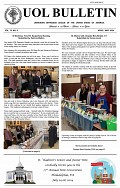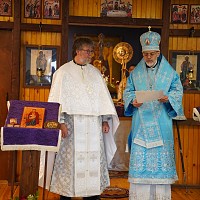The Sunday of St Thomas
Rev. Michael Danczak
On the evening of that day, the first day of the week, the doors being shut where the disciples were for fear of the Jews, Jesus came and stood among them and said to them: "Peace be with you." When He had said this, He showed them His hands and His side. Then the disciples were glad when they saw the Lord. Jesus said to them again, "Peace be with you. As the Father has sent me, even so I send you." And when He had said this, He breathed on them, and said to them: "Receive the Holy Spirit. If you forgive the sins of any, they are forgiven; if you retain the sins of any, they are retained."
Now Thomas, one of the twelve, called the Twin, was not with them when Jesus came. So the other disciples told him: "We have seen the Lord." But he said to them: "Unless I see in His hands the print of the nails, and place my finger in the mark of the nails, and place my hand in His side, I will not believe."
Eight days later, His disciples were again in the house, and Thomas was with them. The doors were shut, but Jesus came and stood among them, and said: "Peace be with you." Then He said to Thomas, "Put your finger here, and see my hands; and put out your hand, and place it in my side; do not be faithless, but believing." Thomas answered Him, "My Lord and my God!" Jesus said to Him: "Have you believed because you have seen me? Blessed are those who have not seen and yet believe."
Now Jesus did many other signs in the presence of the disciples, which are not written in this book; but these are written that you may believe that Jesus is the Christ, the Son of God, and that believing you may have life in His name. (John 20:19-31)
CHRIST HAS RISEN! INDEED HE HAS RISEN!
The Gospel reading for the Sunday of St. Thomas is often used as an exposition on faith. In it, the Holy Apostle Thomas was absent when our Lord appeared to the rest of the Apostles in a shuttered room after His Resurrection. St. Thomas joined them later and expressed doubts as to the event which the other disciples related to him, stating that he would require physical proof of such an occurrence. Eight days later, Jesus again came to the Apostles with St. Thomas present; he allowed St. Thomas to inspect and actually touch the wounds to assuage his uncertainties. Christ gently reproached him about having faith in that which cannot be seen. Most people know this as the story of “the Doubting Thomas.”
The basic lesson about faith is present in the Gospel reading, but a very interesting subtext must also be pointed out. St. Thomas did not only express doubts about the appearance of our Lord; he also questioned the veracity of the other Disciples. He diminished their reliability; he exhibited a level of disunity with a group of people with whom he continuously and intimately shared nearly three years of his life. The Holy Apostle Thomas demonstrated a lack of faith in not only our Lord but also in the remainder of the Apostles.
Faith, in philosophical terms is the acceptance of a presupposition, premise or idea as true without substantive actualizing proof . A simpler way to state this is: faith is a belief in an idea, thing or another person, which has no significant rational justification. Rationality requires that a person must be able to establish that a belief is supported by some form of objective verifiable proof so that any trust which is being placed in a person or concept is the result of an acceptable probability or justification; a presumption of reliability based on quasi-scientific criteria, in such circumstances, however, is not an exercise in faith as much as it is in the methodology which produced the data upon which the judgment regarding dependability of any such notions are based.
To have faith in something or someone, a person must accept the totality of the concept or person without substantiation. There must be an unwavering confidence that your impressions and expectations are true. Will these notions and outlooks be influenced or tempered by the material reality? Most assuredly, belief is always framed by that which is extant in creation; however, there is, within the human creature, the capacity to perceive a reality other than the physical, a metaphysical immutable transcendency that displays itself within the physical reality but simultaneously exists outside of it.
This is the “region” of God. It is not subject to verification or validation by scientific methods; it does not operate within the “laws of nature” as we know them. It is totally outside of time but yet is intimately connected with the physical universe which is dependent on time. On the surface this notion of dual, but interconnected, “universes” appears mutually incompatible, but they none the less exist. In philosophical and theological terms, this relationship is an antimony and it is the cause of a number of misapprehensions regarding God, the life of Jesus and Church teachings.
St. Thomas could not comprehend that his Master had actually returned bodily from the grave after His Crucifixion. To the Apostle Thomas, this return from the dead was a physical and “rational” impossibility in his “universe.” What he failed to understand was that God is not subject to the limitations of our “universe,” because a completely different actuality exists, one in which the temporal and transcendent simultaneously and inseparably co-exist. St. Thomas could not accept the reality of the Resurrection without sensible proof even though Christ had specifically told him and the other Apostles that it was going to occur and even though his fellow Apostles swore that they had seen their risen Teacher in locked room where they had sequestered themselves. In the mind of St. Thomas, the obvious humanity of Jesus logically exceeded His proclaimed divinity; the Jesus that the Apostle perceived lived as a human, so it was only dianoetic that His nature was only to be seen as human within an apparent reality of temporal-spatial limitations which could only produce very human consequences and outcomes; the Apostle Thomas assumed that if Jesus had in fact appeared in the room, as his brothers had described, he could not have been there bodily but only as a spirit or spirit body consistent with some Jewish theology of the time. St Thomas misunderstood the transcendence of God and as a result, he revealed his lack of faith in both Our Lord and his fellow Apostles.
The Apostle Thomas in those few days exhibited a lack of fidelity with Our Lord and His teachings as well as with his brother Apostles. In a very real sense St. Thomas demonstrated the seeds of the philosophical and theological misconceptions which would reappear after the establishment of the Church and eventually lead to the various heresies and schisms with which the Church has had to deal for nearly two thousand years.
Jesus understood the concerns of St. Thomas, it is very difficult to believe in something that is intangible. As mankind exists in a physical realm, man requires that there be a sensual validation of reality; members of mankind must be able to see, touch, smell, taste or hear that which that are asked to accept with certainty. Christ also knew that there are aspects of the reality created by God which lack corporeality; areas of life in which physical senses are either unreliable or useless. The actuality of these aspects of existence must be accepted within the constraints of the revelation of God, which, to many, are nothing more than an assemblage of abstract concepts that may or may not have a tenuous thread of sensual origins. Beliefs can be problematic for some since they rely on nothing more than a confident “feeling” or impression concerning the person or idea in question. That expression of unswerving confidence is faith.
Christ offered proof to St. Thomas of His physical presence and in the expanded reality that He had come to witness. He stood before the Holy Apostle and allowed him to examine His wounds in order to solidify his faith but Christ also offered a gentle reproach to St. Thomas and proclaimed the additional Beatitude: Blessed are those who have not seen and yet believe.
We as Orthodox Christians, are challenged by God to believe without seeing. We are called to expand our consciousness and our intellect to realize that what we see isn't answer to the question “Is that all that there is?” Christ came into this world to demonstrate this very fact; the Son of God condescended to take human form and live under the same self-imposed limitations as we live, in order to demonstrate a path to salvation in the transcendent realm of Heaven. This is what He taught his Apostles and Disciples ; this is why He performed His miracles and this is why He voluntarily ascended the Cross and rose from the Tomb. Jesus demonstrated the actuality of the antimony of “two universes;” Jesus actualized the recognition of a new reality for mankind by His Death and Resurrection Jesus reestablished the possibility of the reacquiring the “Likeness of God” by restoring to a blinded mankind the sight of the totality of the Created. The reality hidden from mankind since the Fall of Adam and Eve. Christ proved the certitude of Heaven and of Hell and He showed us that the way has been opened for us so that we may pass into that transcendent universe and have life everlasting.
Unfortunately, many of us show the dispositions initially exhibited by St. Thomas. We demand proof before we express our faith. We attempt qualify our relationship with God in terms of variety of temporal concerns ; we willfully separate ourselves from each another based on totally arbitrary, useless and irrelevant societal and economic concepts; we attempt to redefine God in our own image instead of accepting that we were created in the “Image and Likeness of God.” Ultimately, we refuse to accept that our Faith and that of all of Orthodoxy is totally dependent on the acceptance of the Teachings and the Salvific Works of our Lord and Savior, Jesus Christ.
Many of us know of people who have left the Church stating that a belief in God is illogical, adopting either an agnostic or atheistic outlook. They look at the state of the world and declare that a benevolent God would not allow misery and pain to exist in the world nor would a compassionate and all loving God permit evil to exist. These people look at God in much the same way as the “doubting Thomas” did. They refuse to appreciate that the physical reality in which they live is not the totality of creation; they either ignore or fail to apprehend the co-existent transcendency that permeates all of creation. They also deny that the state of the “universe,” which they consider to be the extent of their reality, is the result of the Fall of Mankind. Evil, pain, and misery are, in fact, not a Divine product but are human in origin. They move through the various stages of their lives and they begin to realize that that feel that something is missing existentially. Some of these people find their way back into the Church but only after some form of life changing experience. Unfortunately, some of these self dispossessed individuals, because of the “emptiness” that they feel, some become despondent or depressed. Many attempt to fill this void with substance abuse, others by the idolization of sports teams, celebrities, profession and wealth. A fair number join a variety of religious and quasi-religious groups which promise to make their life complete by offering any number of self satisfying or self consoling interpretations of spurious Gospel teachings..
If these unfortunates would stop and consider the lesson of this Gospel reading, they would come to the realization that just as Jesus did not turn away St. Thomas, Our Lord stands ready to accept us in our petulancy and rebelliousness, for in the very same biblical account of the meeting of our Lord with St. Thomas appears the verse: Receive the Holy Spirit. If you forgive the sins of any, they are forgiven; if you retain the sins of any, they are retained." Jesus broadly propped open the door for salvation. Christ gave authority to his Apostles and their successors, the Bishops, and Priest, to remit sins through the Mystery of Penance and Reconciliation.
To begin the process of accepting the fullness of created reality each of us must acknowledge that we have a distorted relationship with God based upon misapprehensions of the created universe which in turn have caused misperceptions as to the unknowable nature and will of God. We must further admit that these existential misconception have caused us to disastrously separate ourselves from our fellow mankind and from God. It is the effects of this separation that have led us into sin. Accordingly, we must also acknowledge that it is sin that is the cause of evil and all the problems present in our world. We must then approach our Lord, God and Savior, through the Sacrament of Reconciliation and confess our misconceptions regarding our actualized reality and of God, and confess our transgressions against one another and God so that we can pray for forgiveness. In this way we will reestablish our fidelity with God and with our fellow mankind and in return receive the undeserved Divine Grace that we need for our Salvation and Eternal Life.
May our Lord God and Savior, Jesus Christ, bless you and protect you. Amen.












